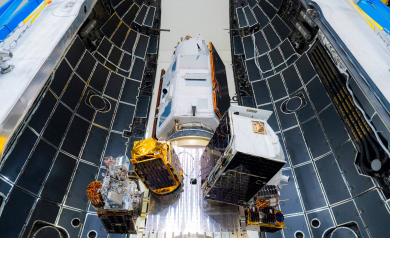Vandenberg Space Force Base, California, 26 August 2025 – Luxembourg successfully placed its first national Earth observation satellite, the National Advanced Optical System (NAOS), into orbit aboard a SpaceX Falcon 9 rocket. Liftoff occurred at 11:53 a.m. Pacific Time in a mission lasting just over one hour. SpaceX confirmed the deployment of NAOS and all rideshare payloads. The rocket’s first-stage booster returned to land at Vandenberg, completing its 27th mission.
From Vision to Capability: Luxembourg’s First Step into Autonomous Earth Observation
NAOS was built by prime contractor OHB Italia for the Luxembourg Directorate of Defence. The satellite is equipped with a very high-resolution camera and will operate in a polar orbit at an altitude of around 450 km. Designed to remain in service for approximately seven years, it will circle Earth once every 94 minutes, or about 15 times per day, and is expected to capture nearly 100 images daily.
NAOS will support applications including military operations, monitoring disarmament treaties, observing troop movements, disaster management, climate change, humanitarian aid, and public administration tasks such as land monitoring. Images will be provided to Luxembourg’s institutions and international partners, including the European Union, NATO, the United Nations, and the International Atomic Energy Agency.

Elbit Systems’ Jupiter Camera
The spacecraft carries Elbit Systems’ Jupiter space camera, which offers panchromatic, RGB, and near-infrared channels. These imaging modes provide high-definition views of the Earth’s surface for analyzing vegetation, water content, and material properties. The camera can capture continuous long image strips, allowing efficient coverage of large areas in a single orbital pass.
Elbit also developed algorithms for the ground segment to enhance Luxembourg’s ability to process and analyze the satellite’s data.
Rideshare Payloads Onboard
Alongside NAOS, the Falcon 9 carried several rideshare payloads. Planet Labs launched Pelican-3 and Pelican-4, part of its next-generation multispectral fleet, and confirmed initial contact with both satellites.
Dhruva Space, based in India, flew its first commercial mission, LEAP-1, which hosted payloads for the Australian startup Akula Tech, including the Nexus-01 AI module and a hyperspectral imager developed by Esper Satellites.
Rideshare integrator Exolaunch deployed four further payloads: Capella Space’s Acadia-6, a third-generation synthetic aperture radar satellite, and three hyperspectral FFLY satellites from Pixxel. With this launch, Pixxel’s commercial constellation now has six operational satellites.
Strategic Step for Luxembourg
The NAOS mission is part of the Luxembourg Earth Observation System (LUXEOSys) and provides the country with its first independent source of high-resolution data. Previously, Luxembourg relied on external providers for such imagery. The project represents a strategic investment, strengthening the nation’s role in defense and environmental monitoring, and establishing its position as a growing space actor.
Reference Points:

